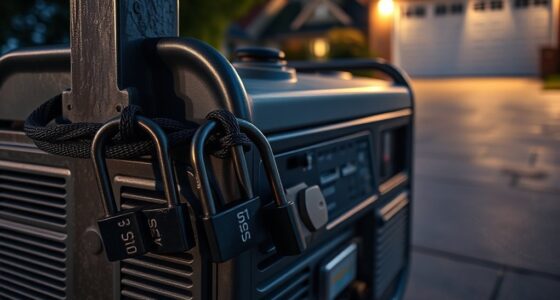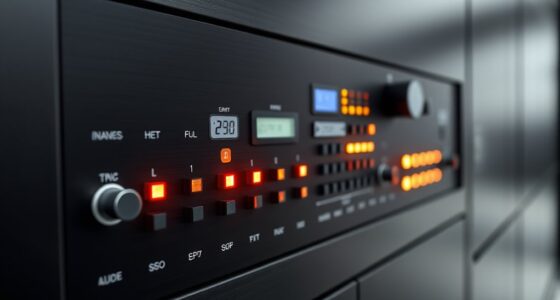To run essential loads on a 30–50A portable generator, first verify your generator’s wattage and match your appliances’ power needs, staggering startup times to avoid overloads. Use appropriate, outdoor-rated cords and connectors compatible with your generator’s outlets. Distribute high-demand devices evenly across circuits, and consider using transfer switches or power panels for safe, seamless switching. Monitoring your load helps prevent overloads, and following safety practices guarantees reliable operation—keep going to learn more about maintaining a safe and efficient setup.
Key Takeaways
- Calculate total wattage of essential devices and ensure it stays within your generator’s capacity (around 7,200W for 30A or 12,000W for 50A).
- Use proper, rated extension cords and connectors compatible with your generator’s outlets and appliance inlets.
- Connect essential loads sequentially, avoiding simultaneous startup of high-demand appliances to prevent overload.
- Employ transfer switches or dedicated outlets for safe, organized power distribution to critical equipment.
- Monitor real-time wattage and voltage to adjust loads and prevent exceeding your generator’s limits.
Understanding Your Generator’s Power Capacity and Load Requirements
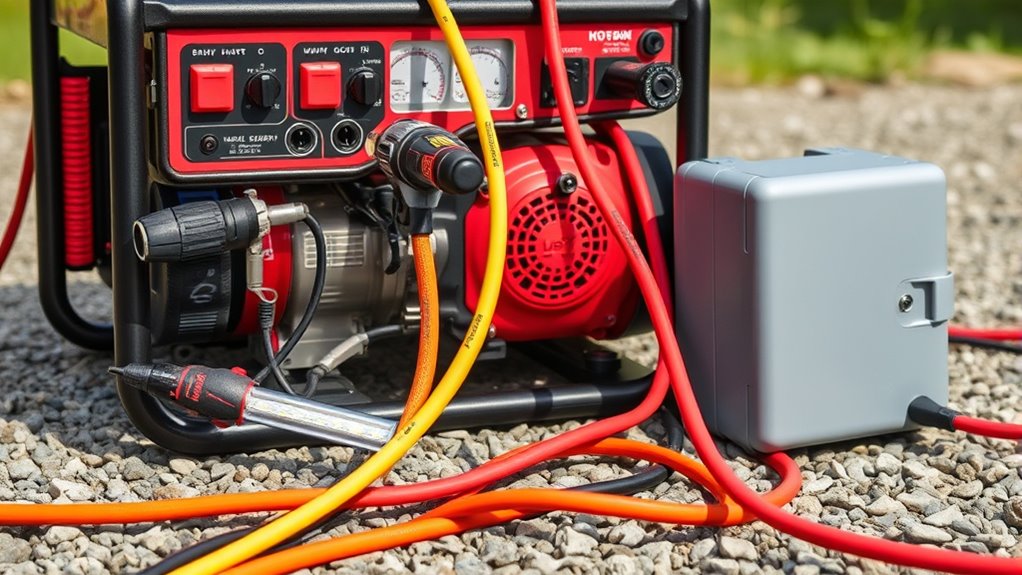
To effectively run essential loads on your portable generator, you first need to understand its power capacity and load requirements. Check the generator’s label or user manual to find its rated wattage, which indicates the maximum continuous power it can supply. This includes both starting and running watts, especially for appliances with motors or compressors. Make a list of your essential devices, noting their wattage. Add up their starting and running wattages to determine your total load. Confirm this total stays within your generator’s capacity to prevent overloads or damage. Understanding these figures helps you prioritize which appliances to run simultaneously and avoid exceeding your generator’s limits, ensuring safe and reliable operation during power outages or remote work. Additionally, being aware of power ratings about your generator’s specifications can help you make informed decisions for optimal performance. Knowing the load management techniques can further ensure your generator operates efficiently and safely.
Selecting the Right Cables and Connectors for Your Setup
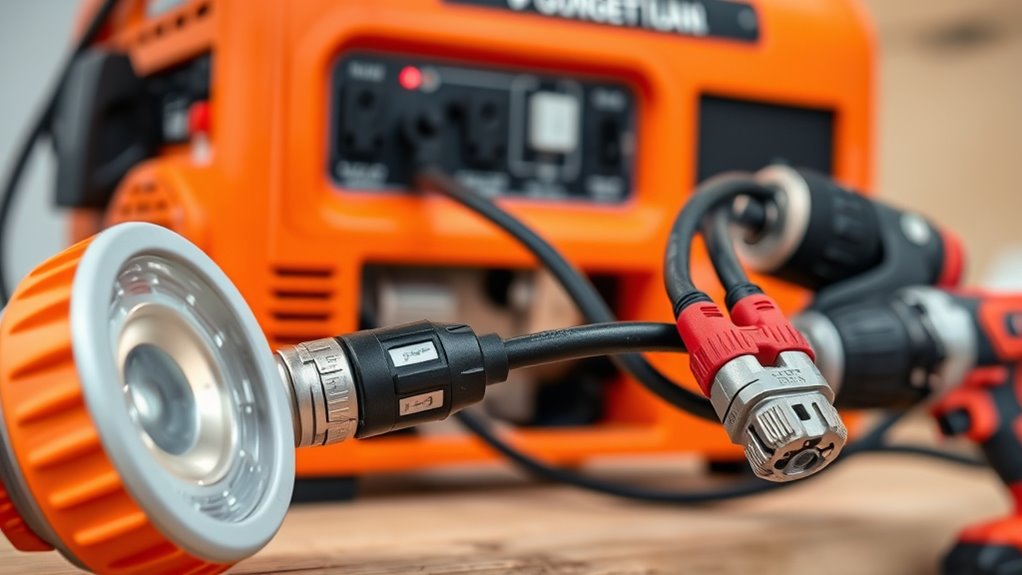
Choosing the right cables and connectors is key to a safe and efficient setup. You need to match cable gauges to your load and guarantee connectors fit properly. Ensuring compatibility with industry standards helps prevent connection issues and safety hazards. Following proper connection practices helps prevent accidents and equipment damage. Additionally, using appropriate materials ensures durability and reliability during operation. When selecting cables, consider the trustworthiness of the brand, as reputable manufacturers are more likely to produce reliable and certified products. Properly rated cables and connectors can also help prevent fire hazards, especially during prolonged use or high current loads. Being aware of zodiac sign compatibility can also guide you in understanding how different components or systems may work together harmoniously.
Cable Gauge Selection
Have you ever wondered how to guarantee your portable generator safely handles your essential loads? Selecting the correct cable gauge is vital. Using too thin a wire can cause overheating and voltage drops, risking damage or failure. On the other hand, overly thick cables can be cumbersome and unnecessary for your setup. To choose the right gauge, consider these factors:
- Total current draw of your loads
- Length of cable runs
- Voltage drop tolerance
- Material of the wire (copper or aluminum)
- Safety standards and local codes
Proper gauge selection ensures minimal power loss, prevents overheating, and maintains system safety. Always refer to manufacturer specifications and industry guidelines to pick the best cable size for your 30–50A generator setup.
Connector Compatibility Tips
Selecting the right cables and connectors is essential to guarantee a safe and reliable connection between your generator and your loads. You need to match the connector type to your generator’s outlet and the devices you want to power. For 30–50A setups, this usually means using NEMA L14-30, TT-30, or similar connectors. Ensure the connectors are rated for your generator’s amperage and voltage to prevent overheating or damage. Check that the connectors fit snugly without forcing, and avoid adapters that don’t match your equipment’s specifications. Using incompatible connectors can lead to poor connections or electrical hazards. Always verify the amperage and voltage ratings before purchasing or connecting cables. Proper compatibility guarantees safe operation and reduces the risk of equipment failure or accidents. Being aware of narcissistic behaviors can also help you identify potential safety issues or manipulative tactics when dealing with unfamiliar or untrustworthy equipment sources. Additionally, inspecting your cables and connectors regularly can prevent unexpected failures during operation. Ensuring that your connectors match your generator’s outlet type is crucial for a secure and efficient connection.
Safe Connection Practices
Ensuring a safe connection between your generator and your loads starts with using the correct cables and connectors. You must select components rated for your generator’s amperage and voltage to prevent overheating or damage. Always verify that connectors are compatible with your generator’s receptacles and your appliances’ plugs. Use heavy-duty, outdoor-rated extension cords with proper insulation. Confirm all connections are secure and free of corrosion. Avoid daisy-chaining multiple extension cords, which can cause voltage drops or overloads. Regularly inspect cables for cuts or frays, replacing damaged ones immediately. Proper grounding is essential to prevent electrical shock. Additionally, selecting appropriate cleaning products can help maintain your generator components and ensure optimal performance. Proper generator maintenance practices can extend its lifespan, improve safety, and help prevent electrical faults that could lead to damage or hazards. Furthermore, following log in security best practices can help protect your setup from unauthorized access and ensure safe operation.
Properly Connecting Your Generator to Essential Loads
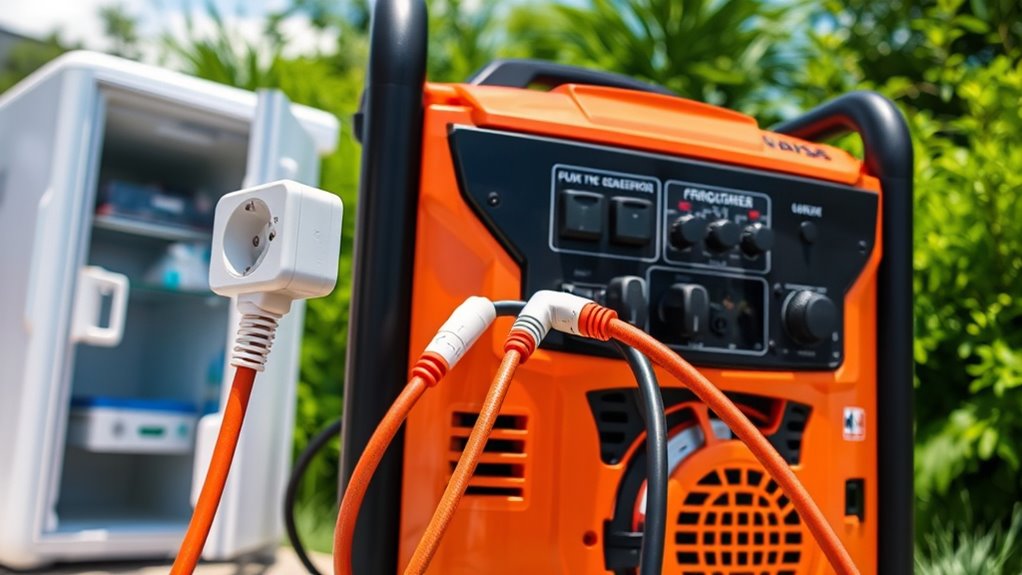
To guarantee safe and effective power transfer, you need to use the correct power cords and connectors designed for your generator and loads. Make sure the load you’re connecting matches the generator’s capacity to prevent overloads. Follow proper connection steps carefully to avoid damage or safety hazards. Additionally, you can use a free online tool to convert text styles for clear and consistent documentation of your setup. Properly managing electrical safety is essential when working with portable generators to prevent accidents or equipment damage. Ensuring your generator has compatible power cords and connectors helps maintain safe operation and optimal performance.
Use Correct Power Cords
Using the correct power cords is essential for safely and efficiently connecting your generator to your essential loads. Using improper cords can cause electrical hazards, damage your equipment, or lead to power outages. Make certain you select cords rated for your generator’s output and the load’s requirements. Use heavy-duty, weatherproof cords with proper grounding. Check that the connectors match your generator’s outlets and the device’s inlets. Avoid extension cords that aren’t rated for high current or long distances. Properly inspect cords for cuts or frays before use, and never force incompatible connections. Additionally, always verify that your cords comply with safety standards to prevent hazards. Ensuring your cords are properly rated helps maintain optimal performance and safety during operation. Remember that beach environments can sometimes expose cords to moisture and sand, which may compromise electrical safety if not properly protected. It’s also advisable to use cords with ground fault circuit interrupters (GFCIs) in outdoor or moist conditions to enhance safety.
Match Load and Generator
How do you make certain your generator supplies the right amount of power without risking overload? The key is to match your load to your generator’s capacity. Start by listing all essential devices you plan to run. Add up their wattages to determine the total load. Ensure this total stays below your generator’s rated output—typically 30A or 50A, translating to around 7,200 or 12,000 watts, respectively. Avoid plugging in everything at once; instead, stagger startup times for large appliances. Use a wattmeter or check device labels to verify your load. By balancing your essential loads carefully, you prevent overloads, protect your equipment, and keep your generator running smoothly. Proper load matching ensures reliable power during outages or remote work.
Follow Proper Connection Steps
Before connecting your generator to your essential loads, it’s crucial to follow a safe and systematic process. First, verify the generator is on a flat, dry surface and turned off. Next, check that all connected appliances are compatible with the generator’s capacity. Then, confirm the power cords are in good condition, with no frays or damage. When plugging in, follow these steps:
- Use proper heavy-duty extension cords rated for your load.
- Connect the generator to essential loads via a transfer switch or appropriate outlet.
- Avoid overloading by connecting only necessary devices.
- Keep the generator in well-ventilated outdoor areas, away from windows.
- Turn off the generator before disconnecting any appliances to prevent surges.
- Be aware of AI Security and the divergence between human and artificial intelligence, as understanding these concepts can inform safer and more effective generator use.
Using Transfer Switches and Power Distribution Panels
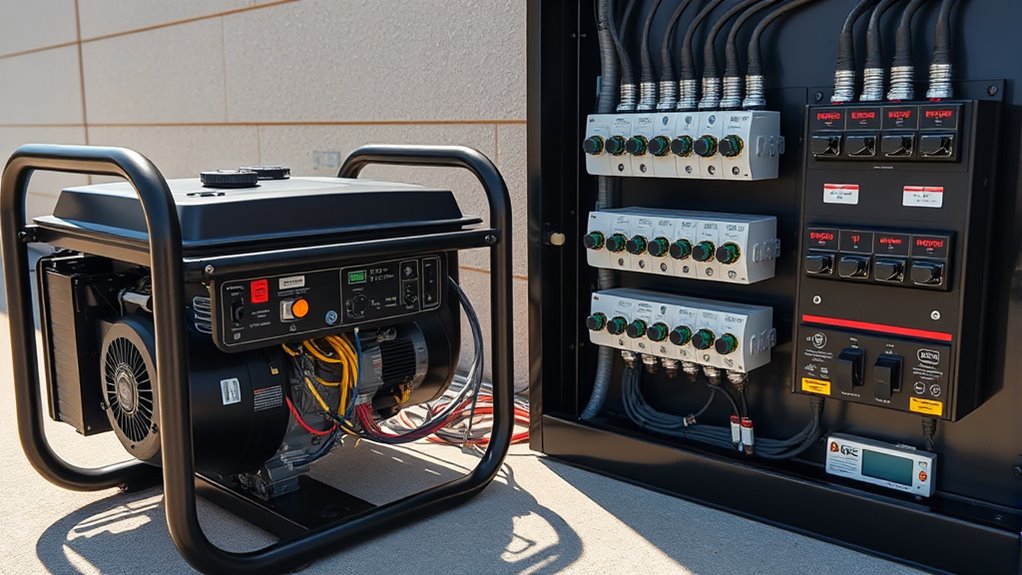
Transfer switches and power distribution panels are essential tools for safely connecting your portable generator to your home’s electrical system. A transfer switch isolates your home from the utility grid, preventing back-feed that could harm utility workers or damage your generator. It allows you to switch seamlessly between utility power and generator power. A power distribution panel organizes your loads, making it easier to manage which circuits run on the generator. When installing, verify the transfer switch is compatible with your generator’s amperage and connects directly to your main breaker panel. Proper installation prevents accidental overloads and ensures safe operation. Using these tools correctly helps you power essential appliances efficiently while protecting your home and equipment during outages.
Managing Load Distribution to Prevent Overloading

Managing load distribution is crucial to prevent overloading your portable generator. You need to balance the power across all connected devices to avoid exceeding the generator’s capacity. Start by listing all essential loads and their wattage. Then, group high-demand appliances separately to prevent overloads. Use power strips with built-in circuit breakers or load management devices to control power flow. Remember to disconnect non-essential devices when running at full capacity. Regularly assess the combined load to stay within safe limits. Keep these tips in mind:
- Prioritize essential equipment to avoid overloading.
- Distribute heavy loads evenly across circuits.
- Avoid running multiple high-wattage appliances simultaneously.
- Use power management devices to control load flow.
- Monitor your total wattage to stay within generator limits.
Monitoring Power Usage and Generator Performance
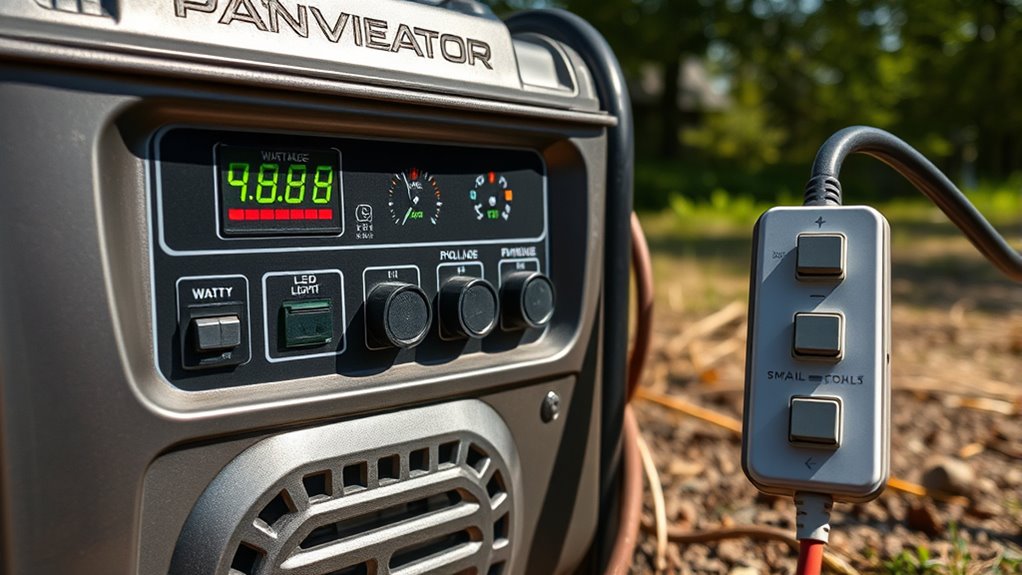
Monitoring your power usage and generator performance is essential to guarantee safe and efficient operation. Keeping an eye on how much load your generator handles helps prevent overloads and ensures longevity. Use a power monitor or gauge to track real-time wattage, voltage, and current. Regularly check these readings, especially when adding or removing loads. To understand the importance of load management, consider this table:
| Load Level | Typical Power Usage | Effect on Generator |
|---|---|---|
| Light | 10-20% capacity | Efficient, safe |
| Moderate | 30-50% capacity | Stable, manageable |
| Heavy | 60-80% capacity | Strains generator |
| Overload | >100% capacity | Risk of shutdown |
| Critical | Essential loads only | Prioritize loads |
Consistent monitoring helps you adjust loads proactively, ensuring your generator runs smoothly and safely.
Safety Precautions When Operating Your Generator
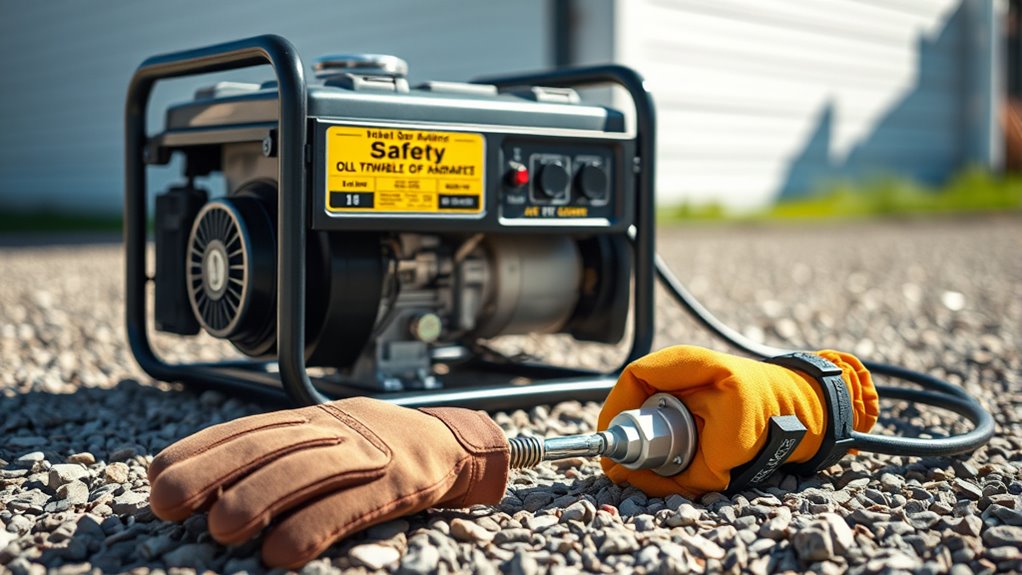
Operating your generator safely is crucial to prevent accidents, injuries, or damage to your equipment. Always operate it outdoors in a well-ventilated area to avoid carbon monoxide buildup. Keep children and pets away from the generator during use. Use proper grounding techniques to prevent electrical shocks. Regularly inspect cords and connections for damage before plugging in appliances. Never overload the generator beyond its rated capacity, and avoid connecting it to your home’s main electrical system without a transfer switch.
Operate your generator outdoors, keep children away, and ensure proper grounding for safe use.
- Confirm the generator is on a stable, level surface
- Use heavy-duty, outdoor-rated extension cords
- Turn off the generator before refueling to prevent fires
- Keep a fire extinguisher nearby
- Follow manufacturer instructions for startup and shutdown
Maintaining and Troubleshooting Your Portable Generator
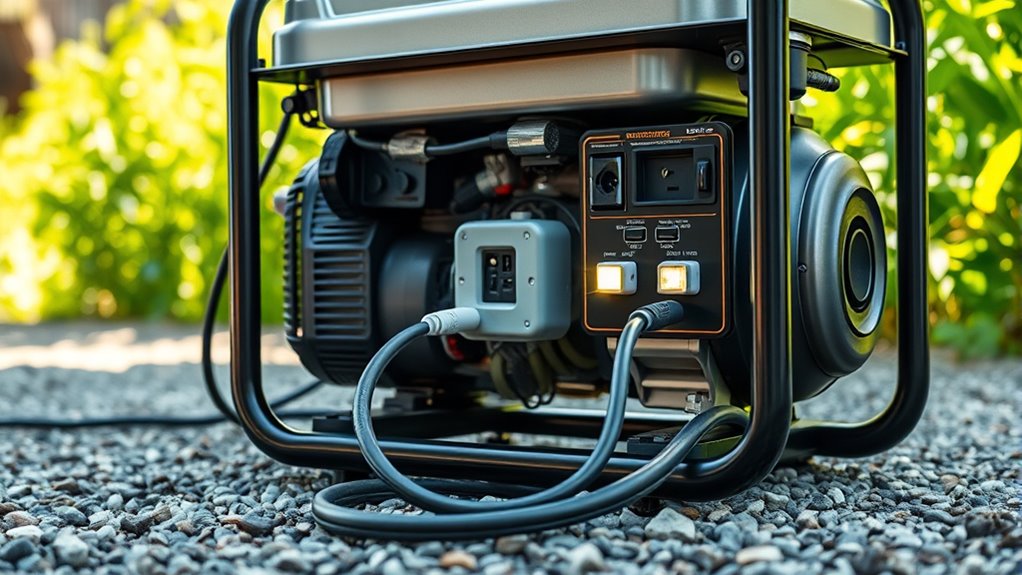
Regular maintenance and troubleshooting are essential to keep your portable generator running smoothly and reliably. You should check oil levels regularly and change the oil based on the manufacturer’s recommendations. Keep air filters clean to ensure proper airflow and prevent engine strain. Inspect spark plugs and replace them if they’re fouled or worn out. Keep the fuel system clean by draining old fuel and using fresh gasoline. If your generator won’t start or runs poorly, troubleshoot by checking for loose connections, clogged filters, or fuel issues. Always consult your user manual for specific troubleshooting steps. Regularly testing your generator ensures it’s ready when needed. Taking these simple steps helps prevent breakdowns and prolongs your generator’s lifespan.
Frequently Asked Questions
Can I Run All My Appliances Simultaneously on a 30–50a Generator?
Yes, you can run multiple appliances simultaneously on a 30–50A generator, but you need to be mindful of the total wattage. Check each appliance’s power requirements and add them up to make certain they don’t surpass your generator’s capacity. Use a power strip with a built-in circuit breaker for safety, and avoid overloading. Distribute the load evenly across outlets to prevent damage and maintain stable operation.
How Do I Determine the Starting Wattage Versus Running Wattage for Loads?
To ascertain starting versus running wattage, check each appliance’s label or user manual, which lists both values. Starting wattage is higher because it powers motors or compressors initially. Running wattage is the continuous power needed during operation. Use a wattmeter if possible to measure actual consumption. Always add a safety margin—about 20%—to ensure your generator can handle the surge when appliances start.
What Are the Best Methods to Prevent Overload During Peak Power Demand?
You can prevent overloads during peak power demand by staggering your appliance usage, turning on high-wattage items one at a time. Use a load monitor or wattmeter to track your power consumption and avoid exceeding your generator’s capacity. Also, prioritize essential loads and turn off non-essentials during peaks. Regularly inspect and maintain your generator to make certain it runs efficiently and handles surges without overloading.
Can I Connect Multiple Portable Generators for Higher Capacity?
Yes, you can connect multiple portable generators for higher capacity, but you need to do it correctly. Use a proper transfer switch or a parallel kit designed for your generator models. Always make certain both generators are of the same make and model, running at the same voltage and frequency. Never connect generators directly without proper equipment, as this risks damage or safety hazards. Consult a professional to set up parallel operation safely.
How Often Should I Perform Maintenance to Ensure Safe Operation?
You should perform maintenance on your generator every 50 to 100 hours of use or at least once a year, whichever comes first. Regularly check oil levels, air filters, and spark plugs, and clean or replace parts as needed. Always follow the manufacturer’s instructions for specific maintenance tasks. Keeping up with these routines guarantees your generator runs safely and efficiently when you need it most.
Conclusion
By understanding your generator’s capacity, choosing the right connections, and managing your loads carefully, you can run your essential appliances safely and efficiently. Always monitor your power usage and follow safety precautions to prevent overloads and damage. Regular maintenance keeps your generator reliable, ensuring it’s ready when you need it most. With these tips, you’ll confidently operate your portable generator, providing essential power during outages or emergencies.




